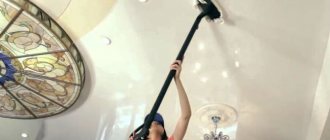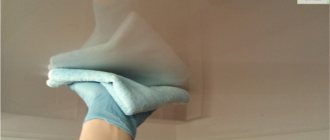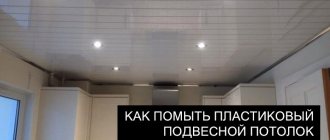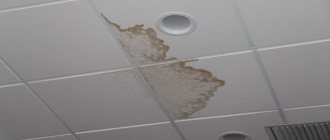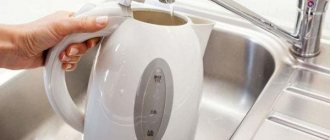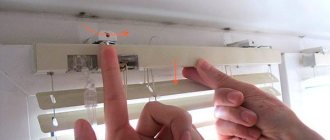Stretch ceilings seem fragile and susceptible to damage, and even installation experts say that this structure requires careful handling. Therefore, owners of such finishing in the house are lost when a stain appears on the film or fabric. This article will talk about how to restore cleanliness yourself using various means and techniques, and when you can’t do without a replacement.
How to wash a PVC stretch ceiling
What you will need
- Dishwashing liquid (or soap solution, or a special solution for cleaning the ceiling);
- mop;
- water;
- microfiber cloth;
- stepladder or sturdy table;
- for a glossy ceiling - glass cleaner or 50 g of vodka.
What do we have to do
Dilute a tablespoon of dishwashing detergent in 3 liters of water. If you are using a special ceiling cleaner, follow the instructions on the package.
Frame: LOVISOVET / YouTube
Soak a rag in the solution and wring it out. First try any detergent on the side of the ceiling: apply, leave for 10 minutes and rinse. If there are no marks or stains left, then you can start washing the entire surface.
Frame: LOVISOVET / YouTube
Stand on a stepladder or table and slowly move the mop along the ceiling along the wall. Move in a straight line - circular movements may leave streaks. Do not press the mop: it is very easy to damage the ceiling film with a careless movement.
Using smooth, straight movements, wash the entire ceiling, rinsing the cloth from time to time.
Frame: LOVISOVET / YouTube
If your canvas is matte, the job is finished. If it's glossy, then there's one more step ahead. Take glass cleaner or prepare an alcohol solution: 50 g of vodka per 0.5 liter of water.
Frame: LOVISOVET / YouTube
Dampen the cloth and wring it out well. Wipe the ceiling with the solution to remove mop marks and add shine to the surface.
Frame: LOVISOVET / YouTube
Types of brushes and mops for cleaning the ceiling
Today, in order for the ceiling to be perfectly clean, housewives do not even need to touch the rag with their hands. Which is very important for children and older people. It is noteworthy that on the market you can find models that disinfect surfaces without the use of chemicals. Which is undoubtedly important for people suffering from allergies or areas where pets live.
Types of mops for wet cleaning of the ceiling:
How to clean fabric stretch ceilings
Due to the interweaving of fibers, fabric ceilings are somewhat more difficult to maintain; dry cleaning is better for them. But if the ceiling is very dirty and you can’t do without wet cleaning, then you can also do it yourself.
How to dry clean a fabric ceiling
What you will need
- Microfiber cloth;
- soft bristle brush;
- stepladder or sturdy table.
What do we have to do
Standing on a stepladder, walk with a soft cloth over the entire ceiling, shaking off dust with light, short movements, without pressing. If there are small dirt or cobwebs on the ceiling, clean them with a soft brush.
How to wet clean a fabric ceiling
What you will need
- Fabric surface cleaner (usually sold as an aerosol or in a spray bottle);
- microfiber cloth or other lint-free cloth;
- soft brush.
What do we have to do
Read the instructions for your cleaning product: details of use may vary. Apply the product to the ceiling fabric with a napkin or, if it is an aerosol, spray it onto the ceiling.
Leave for a few minutes to allow the product to take effect. Remove it with a soft brush or damp cloth. You don't need to wet the ceiling too much, otherwise it will take a long time to dry.
Professional store products
EdelWeiss
How to clean a suspended ceiling without spoiling its appearance? This is a modern cleaning product designed specifically for stretch fabrics. It is packaged in ergonomic bottles that have a spray nozzle, which makes cleaning extremely easy, since you often have to wipe the surface in uncomfortable conditions from a table or stepladder. It is notable for its gentle but effective composition: it contains neither alkalis nor caustic acids, and is safe for both delicate materials and sensitive skin of the hands. Despite such a gentle influence, it copes with dirt perfectly.
Nouvelle
Another popular professional aerosol product designed for ceiling coverings. Harmless and powerful, it removes soap smudges in the bathroom, grease with settled soot, ingrained traces of insects, and dusty stains. The bottle of this universal product is convenient to hold in your hands while cleaning, which is also a huge plus.
Mister Muscle
It perfectly removes dirt on stretch fabrics, including settled fumes from cooking food. Removes any specific kitchen stains without leaving any unsightly marks. It has a non-toxic and non-aggressive effect, making it suitable for all cases.
LOC from Amway
A universal remedy that is loved by many owners. Helps to easily and quickly clean delicate surfaces, even glossy textures, because it does not create streaks and gives the materials a special freshness and shine. Suitable for those who care about their home and do not want unnecessary problems. It may not be worth overpaying, but this is the price of comfortable cleaning and high-quality results.
Kare Noir
An innovative, well-known product that copes with a wide range of contaminants. You can trust him with stretch fabric that needs gentle and effective cleaning.
Other branded products
You can use special compounds recommended by the manufacturer specifically for your ceiling. Who else but the manufacturer knows what exactly is suitable for the surface he creates? If it is not possible to do this, choose any similar product sold in a household chemical store. Just keep the following conditions in mind:
- products with alcohol are suitable for gloss;
- Polishes can handle cleaning glossy surfaces;
- Acetone-containing preparations are strictly prohibited, as they can discolor prints and compromise the integrity of the canvas;
- products with ammonia hydrate or ammonia are the most effective.
How to remove stains from a stretch ceiling
If the ceiling is dirty only in one or two places, then you don’t have to wash it entirely, but simply remove the stains. It is better to remove them immediately while they are fresh.
How to remove a grease stain
Apply a little dish soap to a microfiber cloth and gently rub the stain until it dissolves. Then remove the product with a clean, damp sponge and blot the area where you worked with a dry soft cloth or paper towel.
How to remove a leak stain
If there are yellow stains on the ceiling after your neighbors splashed it, try using washing powder with a bleaching effect. Dissolve a tablespoon of powder in a liter of warm water and wash the stain, then go over the surface with a sponge soaked in clean water.
Hydrogen peroxide can also help. It is applied to the ceiling with a damp, well-wrung out sponge and then washed off along with the dirt.
You can also use ammonia in a soap solution in a 1:1 ratio for PVC fabric.
How to remove a paint stain
Quickly, while the paint is still fresh, remove the stain with a dry cloth. If the paint has already dried, moisten it with a few drops of water and after 5-7 minutes try to wipe off the stain. If it does not dissolve with water, use a cotton swab to apply white spirit or another solvent onto the stain, being careful not to touch the ceiling itself. Wipe off the dissolved paint with another cotton swab or sponge.
How to remove a marker stain
The alcohol marker is wiped off with vodka or a soap solution with the addition of alcohol. The water-based marker can be washed off with a regular soap solution.
How to remove a ketchup stain
Wipe off fresh stains with a damp sponge. Wash any remaining marks with dishwashing detergent and rinse with clean water. If the stain is old, apply soda ash diluted with water on it and leave for 10 minutes. Wipe off with a microfiber cloth.
Operating conditions for glossy tensioned systems
When the apartment has glossy stretch ceilings, such a design can no longer be called simple. By its mere presence, such a ceiling system elevates the room to the rank of status objects. The accents in the interior will shift immediately to the upper part of the room. The glossy surface in combination with a chic chandelier or chiseled lamps becomes the dominant feature of the apartment interior.
This effect will last quite a long time, under one condition - that you have created ideal operating conditions for a tension system of this type and know how to care for a glossy fabric. In this case, literally every little detail is important, starting with how often you should clean and ending with what you need to clean and wash your glossy stretch ceiling.
The question remains relevant, despite the fact that modern models and materials used in this type of design are practical and durable. They do not require special care, but this does not mean that from the moment the repair is completely completed, the glossy ceiling does not need to be touched. The material used to make the canvas is PVC film, a structure that does not require special attention. Impregnated at the manufacturing stage with special compounds, the film repels dirt, dust and liquid components from the surface. According to the certificates, it is clear that under normal use, such a ceiling can last 15 years, without losing its main characteristics and qualities.
The only requirements that apply to the operating conditions of the stretched fabric are compliance with the optimal temperature conditions inside the room. The temperature in the rooms should not fall below 5 C. Otherwise, the fabric will begin to transform and cracks will appear on the surface.
As for other operating conditions, here this type of ceiling design is clearly in the lead. PVC film or polyurethane fabric is completely resistant to moisture and perfectly resists the formation of fungus and mold.
Technologically, the glossy canvas is very convenient for design work in the upper part of the premises. The material is pliable and easy to work with. Combined ceiling systems with complex curved shapes and curved structures at several levels are very popular. The only disadvantage of such surfaces is the difficulty in maintaining them. The presence of blind corners and a large number of levels does not allow you to quickly wash the tension surface, which naturally complicates the process of cleaning ceilings.
What to do to wash suspended ceilings as rarely as possible
- Once every few months, use a microfiber cloth to wipe off dust and minor dirt from the ceiling.
- Before installing a stretch ceiling, check the condition of the pipes: stains from leaks are difficult to remove.
- It is better not to smoke in the room, otherwise the ceiling will turn yellow.
- If a cobweb has formed in the corner, remove it not with a vacuum cleaner, but with a mop and a clean cloth.
- If the ceiling gets dirty, wipe it immediately while the stain is fresh.
- It is worth making a suspended ceiling in the bathroom only if you have a good hood, otherwise it may become damp and stained.
Some useful tips
Stretch ceilings should not be washed every month; excessive wet and mechanical treatment can ruin them. But there are some tips you can use to protect tensile structures and reduce their need for regular cleaning:
- In the bathroom, be sure to use a horizontal splash curtain.
- In the kitchen, you should install a high-quality hood above the stove to minimize splashes and the effect of hot steam.
- Don't forget about ceilings during the holidays. Champagne is the main “culprit” in the appearance of stains on the ceiling in the hall, living room or bedroom.
- In a nursery, suspended ceilings can be damaged by markers if they are not high enough or the baby has access to a bunk bed.
Caring for stretch ceilings at home is simple if, when deciding to install such structures in the house, the importance of handling them delicately is taken into account. Remember that these coatings do not tolerate too intense mechanical impact and super-effective, concentrated products with abrasive particles.
Main causes of pollution
Stretch ceilings are easy to clean
The need to clean suspended ceilings occurs quite rarely. However, after a certain time, contamination can be noticed on the surface of these structures. The reasons for their appearance are operating conditions:
- In the bathroom, after taking water procedures, drops fall on the ceiling, which leave marks when dried.
- In the kitchen, the surface of the tension structure suffers from soot and greasy drops that settle during the cooking process.
- On the balcony, the ceiling is exposed to contamination from street dirt and exhaust gases.
- In other rooms, such as the bedroom, living room or children's room, the ceilings also become dirty. A layer of dust appears on them, especially in summer.
- The structure also suffers after repairs, when a dense layer of construction dust appears on it.

